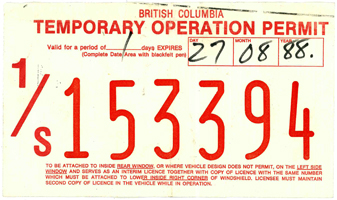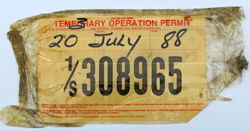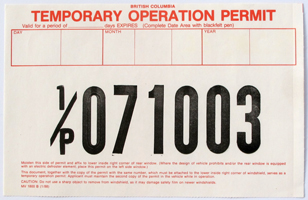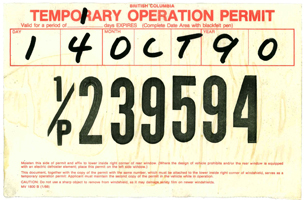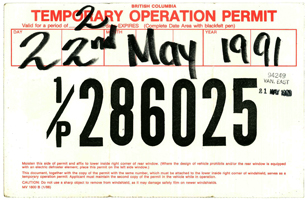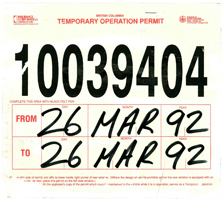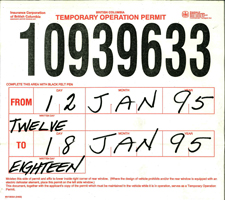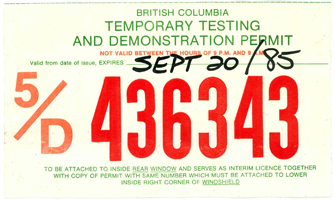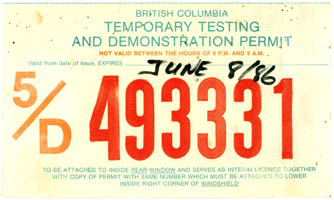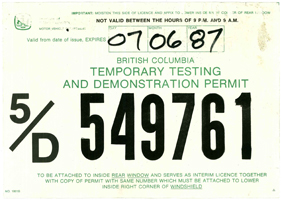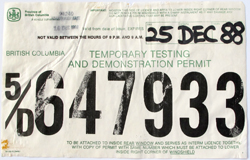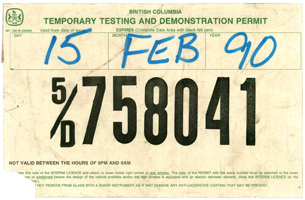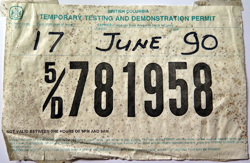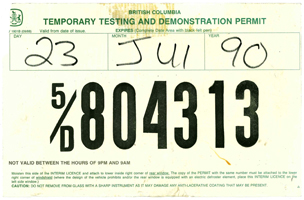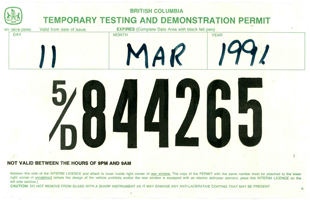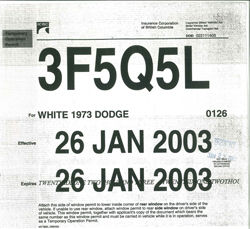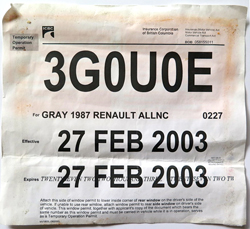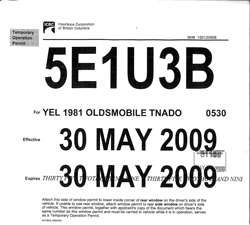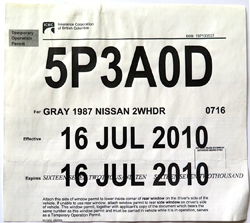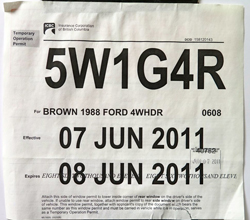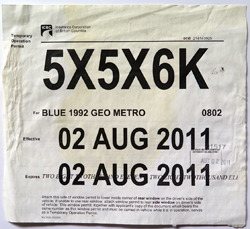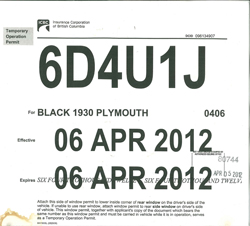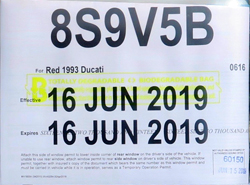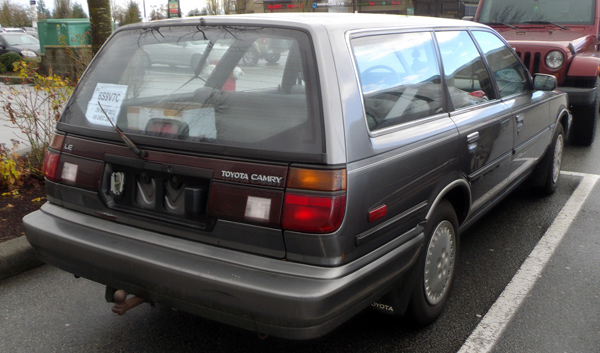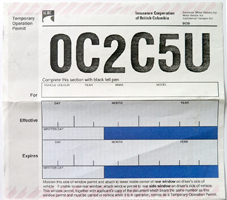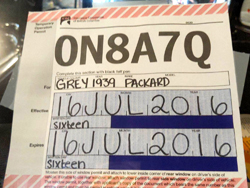|
British Columbia Temporary Operating Permits |
|||||||||||||||||||||||||||||||||||||||||||||||||||||||||||||||||||||||||||||||||||||||||||||||||||||||||||||||||||||||||||||||||||||||||||||||||||||||||||||||||||||||||||||||||||||
Quick Links: |

Sometime between 1928 and 1935, the Motor Vehicle Act was amended to allow the Commissioner (we assume of the Provincial Police) to issue a Permit "for the temporary operation ... of a motor-vehicle or trailer upon any highway for the purpose only of its transportation from one place in the Province to another, without being registered or licenced pursuant to the Act." Of interest, the Commissioner was further authorised to require "the display upon the motor-vehicle or trailer ... special number-plates" that were to be returned to the Commissioner at the expiration of the permit (failure to do so would result in the forfeiting of a deposit). While we are unsure what form these "special number-plates" took, there are a couple of intriguing photos from the 1930s and 1940s showing possible examples: |
 |
.jpg) |
Vancouver Archives: J.M. Brown Motors, Georgia - logging truck (CVA 586-8745) |
|
.jpg) |
* * * * * |
When the Insurance Corporation of British Columbia (ICBC) was being created by the New Democratic Party (NDP) administration of Dave Barret between 1973-74, one of the changes that was introduced to facilitate the implementation of this new government automobile insurance system was the requirement that license plates now stay with a driver and not the vehicle. As described by the (then) Transportation Minister, Robert Strachan in may of 1973, "under the government plan, licence plate numbers issued to individual drivers will stay with the driver when the person sells or trades his car, truck or other licensed vehicle. If he buys another vehicle, the plates will be put on that vehicle after the purchase is completed." More importantly, the government insurance would be obtained by drivers at the time that license plates were being purchased from the newly created Autoplan Agents. By comparison, under the system in place prior to the creation of ICBC, when a car was sold, the license plates went with it and, we assume, were not connected in any way with whatever private coverage a motorists might have had. The transition to this new system formally took affect on November 24, 1973, 3 months ahead of the introduction of ICBC on March 1, 1974. |
For someone who had bought a new vehicle and transferred their license plates to it, attempting to sell their old vehicle became challenging as, without plates on it, no one could legally take it for a test drive. Similarly, attempting to buy a used car if you did not already have plates you could affix to it was equally challenging as, without plates, there was no way to legally drive the vehicle. The solution that ICBC settled upon to deal with these situations was the creation of a "temporary testing permit" that could be used to facilitate the sale of used cars which no longer had license plates. At the time of the release in 1974, the permits were good for a period of 10 days, could be purchased at all Motor Vehicle Branch offices for $7 and were to be affixed to windshields. |
| 1970s | |||||
 |
|
||||
Unfortunately, this is a plate type that has received short-shrift from collectors over the years and we here at BCpl8s.ca have been equally guilty of not following changes in the design and use of these plates and, as a result, the 1970s through the mid-1990s are a bit of a black hole in terms of Temporary Operating Permit knowledge. |
What we assume to be the most type of permit issued throughout the 1980s was the Temporary Operation Permit, which allowed the holder of the permit to drive a motor vehicle on a "one way trip only on a highway within the province of British Columbia". While we don't know what was intended by limiting trips to one-way, or that could even be practicaly enforced, we presume it might have been to discourage commercial use. |
Apart from allowing a vehicle or trailer to operate on any road in the province, the Permit also provided a certain level of insurance coverage:
|
We are still trying to decipher the reference to "1/S" and, later, "1/P" on these permits and suspect it might be a reference to a section of legislation ... |
| Temporary Operation Permits (1980s - 1997) | ||||||
|
||||||
Another type issued throughout the 1980s was the Temporary Testing and Demonstration Permit, which allowed the holder of the permit to drive a motor vehicle on any highway within the province for the sole purpose of: a) roadtesting the described motor vehicle or trailer; or |
Apart from allowing a vehicle or trailer to operate on any road in the province, the Permit also provided a certain level of insurance coverage:
|
The maximum duration of a Temporary Testing and Demonstration Permit was 10 days and its use was limited to between 9:00 am and 9:00 pm. We are still trying to decipher the reference to "5/D" on these permits and suspect it might be a reference to a section of legislation ... |
| Temporary Testing and Demonstration Permits (1980s - 1997) | ||||||
|
||||||
At this time, very little is known about the Interim Licence option and how it differed from the other two types of permits outlined above ... |
| Interim Licence (1980s - 1997) | ||||||
|
||||||
The basics of current format of permits can be gleaned from the Motor Vehicle Act Regulations, which state that a permit cannot be issued for a period in excessive of 15 days while the fees for a passenger vehicle is "the greater of $4/day or $12" - meaning the minimum for a one day permit is going to be $12 (so you might as well get it for 3 days). |
| 1997 - 2020 | |||||||||||||||||||||||
|
|||||||||||||||||||||||
.jpg) |
|||||||||||||||||||||||
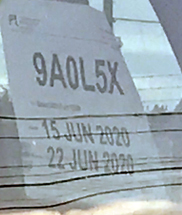 |
|||||||||||||||||||||||
By using a serial that comprises 3 letters and 3 digits with most of the same letter exclusions as is found on the passenger series (i.e. use of the letter "U" is confirmed) it is assumed that approximately 8,000,000 combinations are available under this current 0A0-A0A format. |
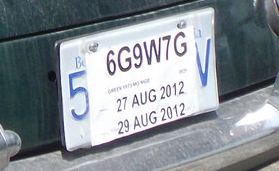 |
.jpg) |
A creative way to display a Temporary Operating Permit and certain to ensure there is no confusion when driving around with expired license plates. Or, as the driver below has done, cover the plate with tape to avoid any confusion. |
|
With the introduction of the new series in 1997 (or thereabouts), the bloc of permits starting at "0A0A0A" through to, we assume, "0Y9Y9Y"(?) were reserved for issuance to vehicles registered outside of BC and which were being brought into the province with expired registration or, for other reasons, required a temportary permit. It is believed that every Autoplan Agent has a pre-printed supply of these permits which contain space for the make of the vehicle and the period of validity to be completed by hand. |
| 1997 - present | |||||||
|
|||||||
In September of 2025, the format Temporary Permits started to appear on the road and, consistent with the Corporation's approach to extending the 6-character format of plate types, the serial was shifted one space to the left (or right, depending on your preference). So, the new serial is now A0A0A0: |
| 2025 - present | |||||||||||||||||||||||
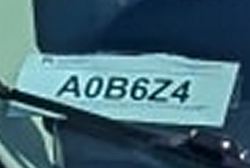 |
|
||||||||||||||||||||||
* * * * * |
| The Future |
Temporary license plates are not without their problems, and these problems are not unique to BC. Foremost amongst these is the nature of their production and the ease with which paper plates that only employ a black-and-white colour scheme can be easily replicated on home printers. |
To combat this, a number of US states have moved to more durable materials and production processes. In Missouri (2019) a new reflective, holographic image capable of being seen at day and night was included on temporary plates as well as an anti-copying feature that produces the word “VOID” if photocopied. |
| While ICBC has not announced any plans to update Temporary plates in BC, it also cannot be put-off forever. |
Quick Links: |
Antique | APEC | BC Parks | Chauffeur Badges | Collector | Commercial Truck | Consul | Dealer | Decals | Driver's Licences | Farm | Ham Radio | Industrial Vehicle | Keytags | Lieutenant Governor | Logging | Manufacturer | Medical Doctor | Memorial Cross | Motive Fuel | Motor Carrier | Motorcycle | Movie Props | Municipal | National Defence | Off-Road Vehicle | Olympics | Passenger | Personalized | Prorated | Prototype | Public Works | Reciprocity | Repairer | Restricted | Sample | Special Agreement | Temporary Permits | Trailer | Transporter | Veteran | Miscellaneous |
© Copyright Christopher John Garrish. All rights
reserved.

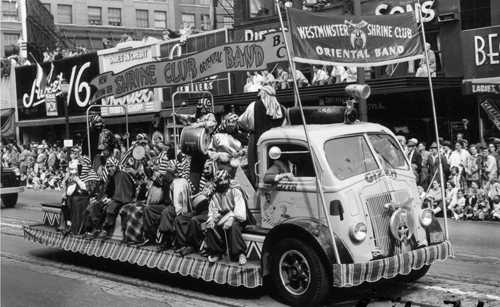
.jpg)
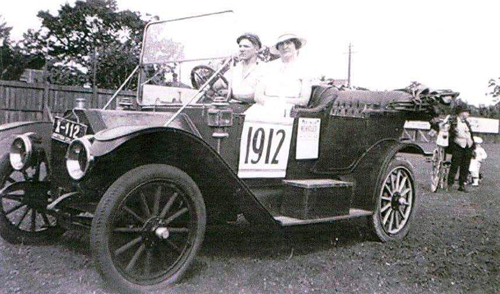
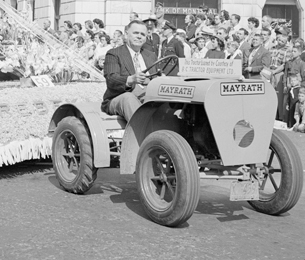



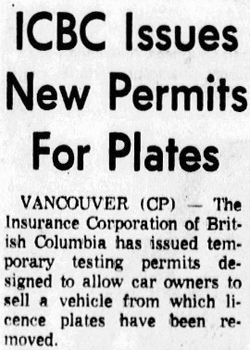 Within 6 months of the government insurance system coming into force, a short-coming of requiring license plates to follow the driver instead of the vehicle had been identified; the re-sale of used vehicles.
Within 6 months of the government insurance system coming into force, a short-coming of requiring license plates to follow the driver instead of the vehicle had been identified; the re-sale of used vehicles. 


